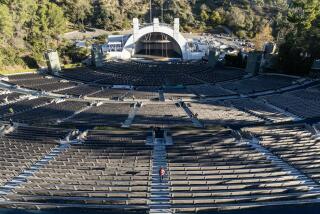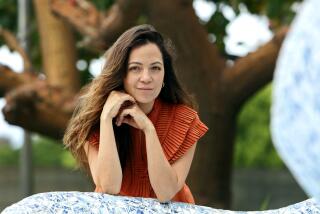Hollywood Bowl’s Bugs Bunny, movie magic
- Share via
Bugs Bunny will return to the Hollywood Bowl this week to help carry on two traditions — a tribute to Looney Tunes and other classic cartoons and the Bowl’s efforts to showcase movie music and the artists who create it.
The Bowl has long been a gateway and gathering place for Hollywood, says Arvind Manocha, chief operating officer of the Los Angeles Philharmonic Assn. “So it’s natural that we want to celebrate the music of Hollywood by hearing it performed live while watching the movies for which it was written.”
Indeed, the hillside amphitheater is not only one of Los Angeles’ major concert venues but also a place to see scenes from films that rarely appear on the big screen these days while listening to the L.A. Phil and the Hollywood Bowl Orchestra.
“There’s something grand about watching a movie with 18,000 other people outdoors,” says Carol Merrill-Mirsky, Hollywood Bowl Museum and Archives director. “Plus, in a theater the music tends to disappear and create an atmosphere. In a setting like this, with the music performed live, you are more aware of it and more appreciative.”
Instead of sticking with the cinema’s greatest hits, the Bowl mixes the famous with the unsung and the unexpected. “We try to bring you the history,” says Manocha, “the behind the scenes and how it came to be.”
“Bugs Bunny at the Symphony,” which will run Friday and Saturday, combines cartoons with commentary by the show’s creator, George Daugherty, who will conduct the philharmonic. “Symphony” is the successor to Daugherty’s “Bugs Bunny on Broadway,” a concert of Warner Bros. classics accompanied by orchestra that premiered in 1990 and has been performed around the world, including at the Bowl nine times.
The new version — which is having a double-premiere here and in Sydney, where it opened in May — retains old favorites such as Chuck Jones’ 1949 “Long-Haired Hare” (in which Bugs takes the podium at the Bowl) while adding material, including the 1950 “Tom and Jerry in the Hollywood Bowl” and pieces from “The Flintstones” and “Scooby-Doo.”
This season’s other film-related offerings started with and will end with movie-musical singalongs in which the audience, aided by subtitled lyrics, joins the soundtrack’s singers and orchestra. Last month, the Bowl screened Paramount Pictures’ “Grease” for the first time. 20th Century Fox’s “The Sound of Music,” a Bowl regular since 2001, will be shown Sept. 25.
“Planet Earth Live,” which will be presented July 23 and 24, is based on the BBC nature documentary series that, Manocha says, “has all the qualities of great filmmaking.” Series composer George Fenton will conduct the philharmonic while clips are shown in high definition, using equipment installed last year. (Among other recent improvements, four side screens were added to the Bowl in 2004. For certain events, a fifth screen is hung center stage.)
Composer John Williams, who often has featured film music during his more than 30 visits to the Bowl, will conduct the Philharmonic in Aug. 27 and 28 programs drawn from his works and Hollywood’s “Golden Age.”
The Bowl’s own annual “movie night” — officially known as “The Big Picture” — salutes composers, genres and studios such as 20th Century Fox, whose 75th anniversary will be celebrated in a Sept. 5 concert in which composer and conductor David Newman will lead the Hollywood Bowl Orchestra.
Movie nights began in the early ‘90s under John Mauceri, then-principal conductor and founding director of the Hollywood Bowl Orchestra. “He’s a big movie-music buff, especially when it comes to composers of the ‘30s, ‘40s and ‘50s,” says independent video producer Laura Gibson, who has worked on Bowl film projects for a dozen years.
For each concert, Gibson and her colleagues search studio archives and other sources. “We look for good scenes with good music. You might have a classic scene but if it doesn’t have music it won’t work.”
Certain choices are obvious, she says, “like the end of ‘ Casablanca.’ ” The American Film Institute announced its top 25 scores at the Bowl in 2005 and its top musicals in 2006 — providing a bounty of material. (The No. 1 picks were “Star Wars” and “Singin’ in the Rain.”)
“But we also do things people won’t expect,” Gibson says. “For Paramount night, we did ‘Wings,’ a silent film with great music that won the first Oscar for best picture.” The Bowl has presented works by composers such as Alfred Newman, Erich Wolfgang Korngold and Max Steiner. “People might have heard their music but not known where it came from.”
Programs usually open with a montage, followed by scenes and clips from specific films “with the orchestra playing in sync.”
Synchronizing sound and image requires extensive research and preparation. Movies from the last 30 years generally have “split tracks,” says Gibson. “Studios give us the dialogue and sound-effects tracks and our orchestra plays the music.”
Older films can be a challenge. “It’s like a treasure hunt,” says Gibson. Among the found treasures: Judy Garland’s vocal tracks for the “Born in a Trunk” sequence from the 1954 “A Star Is Born” and “ Gene Kelly’s original taps from “Singin’ in the Rain.”
During a performance, some conductors and musicians wear earpieces to listen to a click track that indicates the music’s tempos. Some conductors view streamers and punches — visual cues that appear on a screen showing the clips.
“John Mauceri used to joke in his introductions that if we get off track we’ll just start over,” Gibson recalls. “Fortunately, we’ve never had to do that.”
The Bowl has its own long history in the movies. Since it opened in 1922, the venue has appeared in films including “Jazz Mad” (1928) and the 1937 “A Star Is Born.” Gene Kelly and Frank Sinatra climbed up and into the steep amphitheater in “Anchors Aweigh” (1945). Katharine Hepburn landed a hot-air balloon in front of the stage in “Olly Olly Oxen Free” (1978). And in “Long-Haired Hare,” conductor Bugs Bunny brought the house down by making an opera singer hold a high note for so long it shattered the Bowl’s shell.
“Audiences love seeing that,” Gibson says. “It’s one of the special moments in watching movies at the Bowl.”
More to Read
The biggest entertainment stories
Get our big stories about Hollywood, film, television, music, arts, culture and more right in your inbox as soon as they publish.
You may occasionally receive promotional content from the Los Angeles Times.










